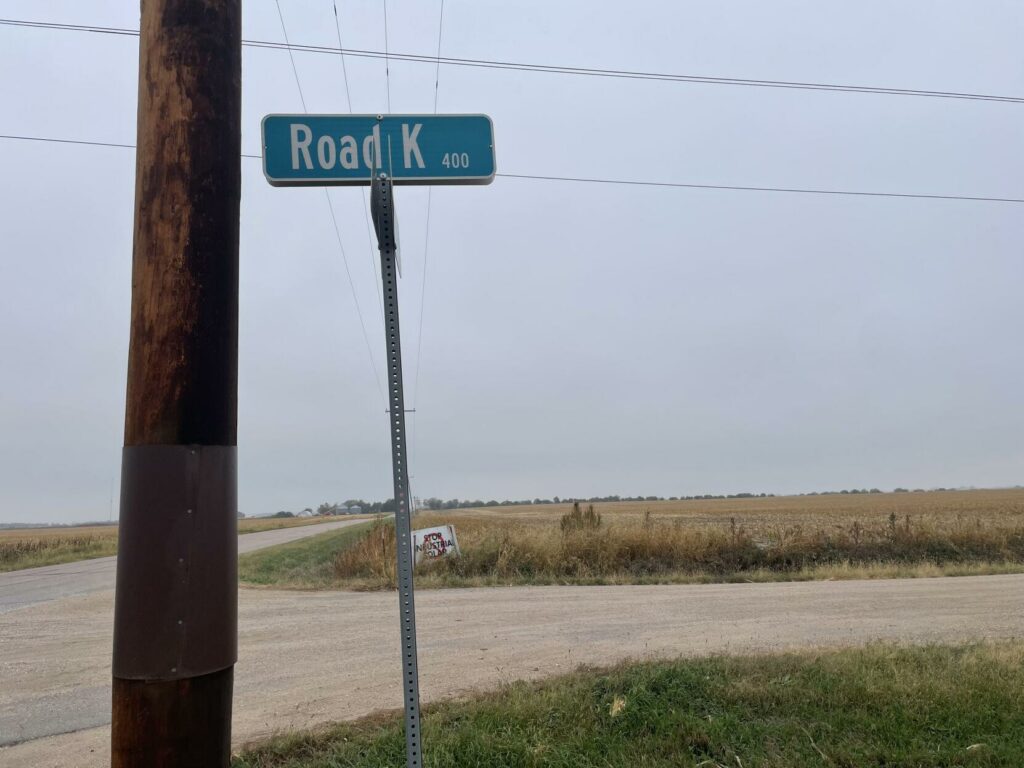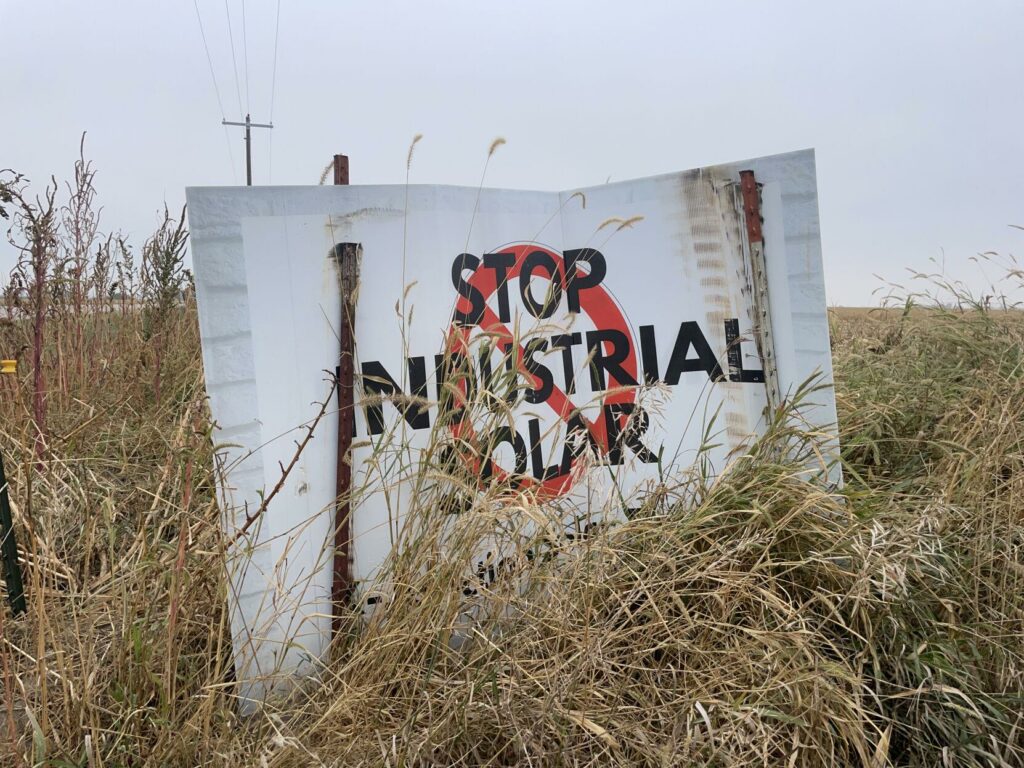
Written by William Swett York News-Times
MCCOOL JUNCTION — More than one hundred participants packed the Stone Creek Event Center to discuss a proposed solar panel project in McCool Junction. The Omaha Public Power District-hosted “community conversation” featured a variety of area residents at different round tables — and a variety of thoughts on the project.
Brad Underwood, vice president of systems transformation at OPPD, told Thursday’s audience that OPPD’s primary goal that night was to “listen.” After a brief presentation in which Underwood explained to the audience why OPPD had decided to purchase the rights to build the solar panels on about 2,800 acres of land in McCool in August, the group broke into smaller conversations.
The solar facility would provide approximately 310 megawatts and has the potential to power approximately 59,000 homes, according to materials from OPPD.
At each of the tables, a representative from OPPD was present to write down “concerns, perspectives, and hopes” from community members about the solar project. Then, the group got back together for a larger discussion so everyone could hear those thoughts.
Community members shared a wide range of perspectives. Many residents expressed concerns about the economic, environmental, and practical effects of the project.
Residents had questions about why the lease agreements gave OPPD the rights to build water wells near the solar panels. Some residents expressed concern that the water from the wells might be exported elsewhere in the state.
In response, Underwood explained that the water would be used for construction and maintenance. According to the lease’s language, shared at the meeting by OPPD, the water may only be used for the “development, construction, operation, and maintenance of the Project, and state law.”
Other residents were concerned about the effects of solar panels on the temperatures of nearby properties. According to Underwood, while some research suggests that there can be a change of up to a degree or two within a facility, there is no evidence of effects on nearby facilities.

F. John Hay, extension educator at the University of Nebraska-Lincoln, told the News-Times that research into agrivoltaics, which is the practice of combining agriculture and solar farming, shows that crops can perform well even if they are grown within a solar facility. This suggests, according to Hays, that negative effects because of temperature on nearby agriculture is unlikely.
A 2016 study from the Barron-Gafford Research Group at the University of Arizona found that air temperatures were indistinguishable at a distance of 30 meters from a solar array.
On more practical issues, Underwood also clarified that OPPD is not using eminent domain in this project since there are willing landowners and also explained how OPPD approaches the decommissioning of a solar project.
Residents also shared concerns about the economic effect that taking out this productive farmland could have on the community. Underwood shared some of the economic benefits that a solar project could have on the community, including a direct tax revenue thanks to the Nameplate Capacity Tax, and also the employment of small businesses for the construction of the project, and, to a lesser extent, for its maintenance.
Still, even after the discussion, some residents expressed concern to the News-Times about what this could mean for local agricultural businesses in York County.

Gene Jackson, a resident of McCool and neighbor to the proposed site, spoke to the News-Times both before and after the meeting. He said that fewer farmers will be buying products like fuel, fertilizer, seed, or parts, so there will be a serious impact to the economy of York County.
“What benefit is it for people here? Zero. Omaha is going to benefit,” Jackson said.
According to Jackson, there “would have to be some real strong data to convince” him that the positive economic impact from the construction and maintenance of a solar farm would be greater during the decades of its use than the positive economic impact from farming on that land during that same period.
“We live here. It will affect (us). And there is no really no economic gain for York County or Hays Township, and the businesses in here will lose revenue,” Jackson said.
According to a study cited by OPPD, construction on the project alone would have an estimated net — accounting for lost agricultural production — economic impact of $180 million, plus an estimated $16 million per year from maintenance.
A larger topic of discussion was why OPPD was pursuing a solar project here in the first place. The project was originally developed by EDF Renewables, which ultimately decided to sell the rights to the property to OPPD in August.
Underwood explained that OPPD likes to have various sources of energy — everything from solar to coal. The environmental circumstances in Nebraska are conducive to solar power, Underwood told the group.
One of the reasons that OPPD decided to purchase the rights for this particular project is because there is a substation owned by OPPD in McCool Junction near to where the solar panels will be, Underwood said.
Even so, there was a sense among residents that agriculture would be a better use of this land, given how suitable it is for growing corn and soybeans.
However, while barren terrain is often thought to be the most productive area for solar energy, a 2019 study from the peer-reviewed scientific journal Nature found that the best terrain for solar energy production is actually cropland, like the kind found in Nebraska.
That is part of why there is a growing interest in combining solar panels and agriculture into agrivoltaic systems. If 1% of worldwide cropland were converted to agrivoltaic use, global energy demand would be “offset,” according to the study.
OPPD expressed interest on Thursday in looking into agrivoltaic use. Some residents expressed excitement about the possibility, while others expressed skepticism about whether or not it could happen.
Still, even if it is not possible to combine agriculture with solar at K-Junction, the name for the project because of its proximity to Road K, there are other reasons to think that solar might be a productive use of the land.
Scott Shaw, an associate professor of chemistry at the University of Iowa, whose family farms corn in Iowa, told the News-Times that he likes to compare solar and corn in terms of energy production since so much corn is used to make ethanol — around 40% in Nebraska, according to a study from the University of Nebraska-Lincoln.
Research suggests that solar may be a more efficient use of land in terms of energy production, Shaw said. Shaw estimated that an acre of corn on a productive farm can produce roughly 600 gallons of ethanol per year, while an acre of solar panels can produce roughly 120,000 watts, enough to power 100 homes.
Despite the concerns expressed at the meeting, other community members voiced hopes about the positive economic impact that the project could have on York County. Others still said that they appreciated “that we have the ability to express our opinions in this space.”
OPPD told the community that there would be more conversations to come.
Before any construction can begin, the York County Board of Commissioners will need to approve zoning regulations for the project.
And before that happens, on Tuesday, the Board of Commissioners will reconsider the appointment of a new member, Luke Gruber, to the zoning board, which is in the process of drafting the zoning regulations for the K-Junction solar project. Luke Gruber’s appointment was postponed last week after Jackson, representing a group of people living near the proposed project, raised concerns that Gruber would be biased in favor of the solar project because of an alleged connection between his employer, Perennial Public Power District, and OPPD.



































